Table of Contents
Gut health
To properly apply food therapy to support individuals with gastrointestinal conditions first thing that needs to be done is to diagnose the patient. It can be done through analysis and recognition of the symptoms or by sending the patient over to a medical specialist or their GP for further testing. After appropriately diagnosing the patient’s condition further actions needs to be taken. Depending on the condition that the patient is suffering from a specific approach will be considered. The treatment for patients with chronic constipation would be completely different from the treatment proposed for a patient suffering from celiac disease and it is within the nutritional therapist’s scope of practice to appropriately apply an adequate therapy type. The therapy itself will consider inclusion, exclusion and manipulation of ratios of certain foods. For example, if the therapy aims to treat a patient suffering from constipation, then it will focus to deliver foods that ease passing the stools. Such foods would be typically high in fibre and an increased fluid intake would be recommended as it complies with the goals of the therapy(1). If the constipation is caused by excess stress, then the patient could also be referred to a specialist (counsellor or psychotherapist) that would help them deal with emotions in stressful situations. If the patient suffers from celiac disease, then products containing gluten (e.g. wheat, rye, barley etc.) would be excluded from the diet and the patient would be recommended non-gluten meals instead (e.g. buckwheat, rice, beans, quinoa, millet, chickpeas, etc.). If the patient suffers from IBS pro-inflammatory foods will be excluded from the diet, while anti-inflammatory foods will be recommended. In the case of IBS following recommendations could be given to the patient(2).
Gut health foods
Stick to a low FODMAP diet that contains:
- Carbohydrates, which are easy to digest (e.g. fruits such as apples, berries, cherries, mango, pears, plums, watermelon that could also be ingested in form of a smoothie), vegetables (e.g. beans, cabbage, garlic, lentils, mushrooms, peas etc.)
- Dairy products such as milk, soft cheese, yoghurt or kefir
- Products with alcohol sweeteners (ending with “-ol”) such as sorbitol, mannitol, xylitol, maltitol or erythritol
- Honey and foods with high fructose corn syrup
- Wheat and rye products
How to improve gut health
According to the GI Society, other recommendations that could be given to the patient are(3):
- Increase the intake of water
- Increase the intake of fibre, however, try to avoid brain fibre as it may aggravate some of the IBS symptoms
- Try to avoid spicy foods as some people may have problems with them
- If a food that is a potential trigger for IBS is to be introduced back into the diet, it would be introduced gradually, with time and in small amounts
- Enjoy meat, chicken and fish
- Some people could benefit from eating 1-3 teaspoons of soluble fibre supplement before ingesting a meal that could be a potential trigger
All of these cues could be applied to a person suffering from IBS, however, the main point of the essay is that the disease needs to be diagnosed at first and then treated to apply nutritional strategy the therapist has to follow an initial assessment to determine what could be a potential issue for his patient.
References:
- NHS, Constipation, accessed on 13/05/21, available at: https://www.nhs.uk/conditions/constipation/
- NIDDK, Eating, Diet, & Nutrition for Irritable Bowel Syndrome, accessed on 13/05/21, available at: https://www.niddk.nih.gov/health-information/digestive-diseases/irritable-bowel-syndrome/eating-diet-nutrition
- GI Society, Irritable Bowel Syndrome (IBS) and Diet: The Foods You Can Eat, accessed on 13/05/21, available at: https://badgut.org/information-centre/health-nutrition/ibs-the-foods-you-can-eat




